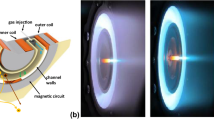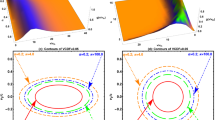Abstract
The flow of a plasma with different component temperatures in the boundary layers at the electrodes of an MHD channel is investigated without any assumptions as to self-similarity. For the calculation of the electron temperature, the full energy equation for an electron gas [1] is solved with allowance for the estimates given in [2]. In contrast to [3, 4], the calculation includes the change in temperature of electrons and ions along the channel caused by the collective transport of energy, the work done by the partial pressure forces, and the Joule heating and the energy exchange between the components. The problem of the boundary layers in the flow of a two-temperature, partially ionized plasma past an electrode is solved in simplified form by the local similarity method in [5–7]. In these papers, either the Kerrebrock equation is used [5, 6] or the collective terms are omitted from the electron energy equation [7].
Similar content being viewed by others
Literature cited
S. I. Braginskii, “Transport phenomena in a plasma,” in: Problems in Plasma Theory [in Russian], No. 1, Atomizdat, Moscow (1963).
V. V. Gogosov and V. M. Korovin, “The solution of the boundary layer equations at the electrodes in a fully ionized plasma with different component temperatures,” Izv. Akad. Nauk SSSR, Mekhan. Zhidk. i Gaza, No. 5 (1970).
L. E. Kalikhman, “The boundary layer of a two-temperature plasma at the electrodes of a magnetohydrodynamic channel with crossed electric and magnetic fields at high values of the Hall parameter,” Zh. Prikl. Mekh. i Tekh. Fiz., No. 3 (1969).
L. E. Kalikhman, “An approximate method for calculating the boundary layer of a two-temperature plasma at the electrodes with high values of the Hall parameter,” Zh. Prikl. Mekh. i Tekh. Fiz., No. 1 (1970).
G. C. Oates, J. K. Richmond, Y. Aoki, and G. Grohs, “Loss mechanisms of a low-temperature plasma accelerator,” JARS,32, No. 4 (1962).
V. V. Proshkin, “The boundary layer of a weakly ionized gas at the electrodes of a MHD channel with allowance for the electron temperature runaway,” in: Problems in the Physics of a Low-Temperature plasma [in Russian], Nauka i Tekhnika, Minsk (1970).
H. A. Claassen, “The laminar magnetogasdynamic electrode boundary layer of a thermal nonequilibrium plasma,” Electricity from MHD, Vol. 4, Vienna (1968).
E. L. Resler, Jr., and W. R. Sears, “The prospects for magnetoaerodynamics,” J. Aeronaut. Sci.,25, No. 4, 235 (1958).
I. Yu. Brailovskaya and L. A. Chudov, “The solution of the boundary layer equations by a difference method,” in: Numerical Methods and Programming [in Russian], 1st ed., Izd-vo MGU, Moscow (1962).
V. V. Gogosov, “Boundary layers in a fully ionized two-temperature plasma,” Prikl. Matem. i Mekhan.30, No. 3 (1966).
V. V. Gogosov, “The boundary layers in a two-temperature plasma,” in: Electricity from MHD, Vol. 2, Vienna (1966).
V. M. Korovin, “Studies of the boundary layers of a fully ionized two-temperature plasma at a nonconducting wall in a MHD channel,” Izv. Akad. Nauk SSSR, Mekhan. Zhidk. i Gaza, No. 5 (1972).
Author information
Authors and Affiliations
Additional information
Translated from Zhurnal Prikladnoi Mekhaniki i Tekhnicheskoi Fiziki, No. 5, pp. 3–10, September–October, 1972.
The author thanks V. V. Gogosov and A. E. Yakubenko for interest in this work.
Rights and permissions
About this article
Cite this article
Korovin, V.M. The boundary layers of a fully ionized two-temperature plasma with given component temperatures at an electrode. J Appl Mech Tech Phys 13, 603–609 (1972). https://doi.org/10.1007/BF00850872
Received:
Issue Date:
DOI: https://doi.org/10.1007/BF00850872




